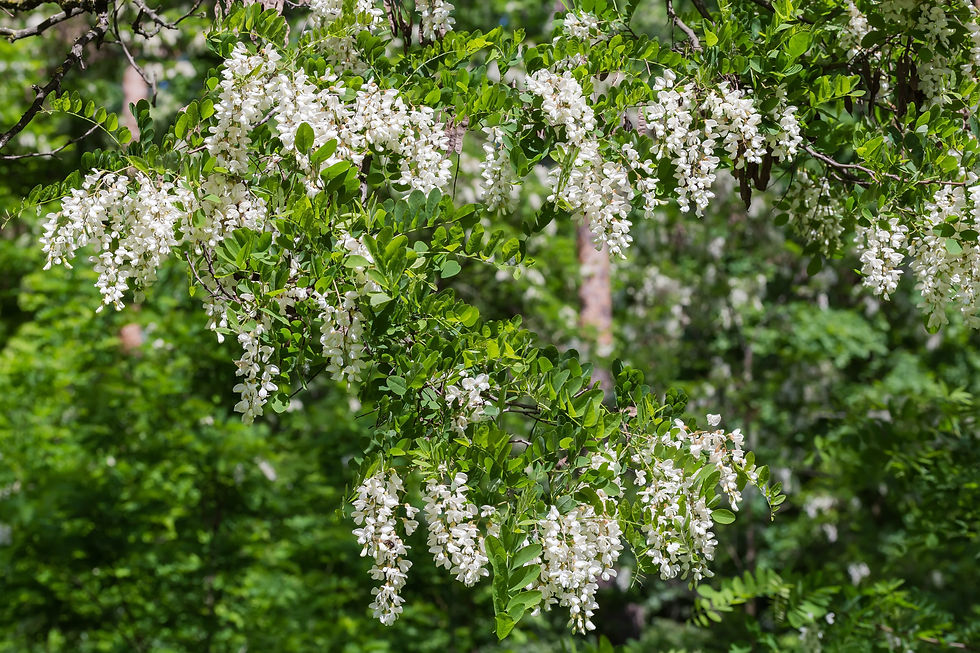Known for its rot-resistant wood, thorny branches, and distinctively furrowed bark, black locust is an attractive and valuable ornamental tree found throughout Ohio. The deep grooves of the bark seem to flow as they form unusual, diamond-like shapes. In late spring, the tree blooms briefly with wisteria-like clusters of extremely fragrant white flowers that produce “acacia honey,” one of the finest-tasting honeys in the world (another common name is fragrant white locust). Locust’s compound leaves have ovate, rounded leaflets similar to those of acacia trees, giving rise to the common name of false acacia. Because it thrives in full sun, black locust is often found on the margins of woods where it doesn’t get shaded out by taller trees. It grows in a wide range of well-drained soils and is quite adaptive to various sites and elevations. It grows quickly--up to 4 feet per year when young and 2 feet per year when older—and reaches heights of 60 to 80 feet with branches spreading upwards into an irregular crown. Because of its fast growth, ability to tolerate poor soils, and widespread and suckering roots, black locust is used for erosion control and land reclamation. Like other members of the Fabaceae family, locusts are nitrogen-fixing trees. Indeed, black locusts are often removed from areas with sand dunes and barrens because they enrich the soils so greatly that previously absent weedy species are able to become established.
Due to the strength, rot resistance, and incredibly high heating value of its wood, black locust trees were planted extensively by early settlers. Currently, its range covers all of the lower 48 states; it has also spread globally. In 1601, black locust was the first native North American tree species to be exported to Europe. The durable wood is one of the hardest domestic hardwoods of North America and the most resistant to rot because of a high concentration of lignin--a complex natural polymer that resists rotting--within the heartwood, as well as the presence of two fungus-killing flavonoids. This makes the wood highly desirable for outdoor uses, such as fence posts, mine props, and railroad ties. The first buildings in Jamestown were erected on black locust poles, and the garden beds at the Colonial Garden in Williamsburg are still lined with the timber. Native Americans were well acquainted with the attributes of black locust; they reportedly brought the tree from the mountains to the plains for domestic use, and they used the nearly unbreakable wood to make their bows. The wood is not entirely indestructible, however; several fungi species can rot the heartwood, making the wood useless for lumber. The fungi gain entry to the tree via wounds that are usually caused by the locust borer and locust twig borer.
Native habitats include borders of woods, thickets, waste areas, and banks of streams. It’s a useful shade tree for open areas, fence lines, borders, windbreaks, and butterfly and native gardens. The trees sucker heavily, so remove new saplings throughout the year unless you want a thicket of black locusts.
Plant Characteristics:
Grows 60-80’ tall and 20-30’ wide.
Prefers full sun.
Prefers well-drained sandy or silty loam, but grows in clay and other soil types. Soil can be moist or medium moist, but it must drain well. Dry soil and drought are not well tolerated.
Flowers are about ¾” long, 5 petaled, and pea-like, hanging in clusters 4-7” long. The flowers give way to flat, dark-brown seedpods with straight edges that are approximately 2-4″ long by 1/2″ wide. Each pod contains 2-12 hard, kidney-shaped seeds that are 1/4″ in diameter. Pods begin to ripen and split open in September, dispersing the seeds.
Leaves are light green at first, changing to blue-green when mature and yellow in fall. The compound leaves are 6-18″ long, and individual leaflets are 1-2″ long with rounded, slightly notched tips and smooth margins.
Trunk is 1-3’ in diameter at maturity and covered with reddish-gray to black bark. Young bark is rough with shallow grooves that deepen as the tree ages. Bark on branches is brown with white lenticels, and new growth is red in color. Mature branches are rough and furrowed. Thorns occur in pairs along smaller branches. Locusts have shallow, lateral root systems that can spread 50 feet from the tree. Sometimes deep taproots develop.
Wildlife Value:
Black locust is a host plant for 61 species of Lepidoptera larvae, including the black-spotted prominent, luna (both pictured here), black zale, and honest pero moths. The flowers of black locust are mainly pollinated by bumble bees, but hummingbirds, butterflies, honey bees, and moths also visit the flowers.
Black locust trees and their seeds are toxic to most mammals; however, the seeds are eaten by many species of game birds, including grouses, quails, pheasants, and turkeys. The evolutionary strategy of thorny branches dissuades most mammals from browsing the foliage, but deer sometimes do so anyway. The plants form dense thickets that provide excellent cover for deer, coyotes, foxes, skunks, game birds, and other mammals.
While heart rot fungus is damaging to the tree and to its commercial value, it does create an excellent habitat for woodpeckers to build cavity nests.
Medicinal, Edible, and Other Uses:
Native Americans chewed the bark as an emetic and used the roots to treat toothaches. The flowers are considered to be antispasmodic, aromatic, diuretic, emollient, and laxative. They are used for eye ailments and may contain an antitumor compound.
Black locust wood was used by Native Americans as a building material for making bows, blowgun darts, and fence posts.
top of page
$17.50Price
Excluding Sales Tax
Only 6 left in stock
bottom of page

